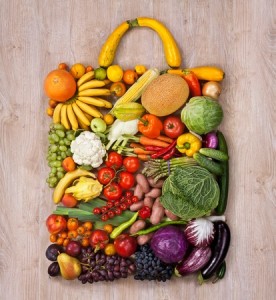 Most of us are familiar with the food pyramid designed by the USDA. The purpose was to help Americans visualize the portions for each food group that is considered best for optimal health and nutrition. The first version was released in 1992 and pictured a pyramid with the largest base being dedicated to bread, rice, cereal and pasta, the next layer vegetables and fruit, the third layer dairy products and meat, nuts, beans and eggs, and lastly fats, oils and sweets in the smallest section on the top. After going through several different versions over the years, the most recent rendition has been simplified to a circular plate (known as “My Plate”) with four divisions of fruits, grains, vegetables, and proteins and a cup near the plate representing dairy. Grains and vegetables are the largest portions on the plate. Most Americans recognize this as a balanced way to approach nutrition, however much research has surfaced in recent years about the merits of plant-based eating.
Most of us are familiar with the food pyramid designed by the USDA. The purpose was to help Americans visualize the portions for each food group that is considered best for optimal health and nutrition. The first version was released in 1992 and pictured a pyramid with the largest base being dedicated to bread, rice, cereal and pasta, the next layer vegetables and fruit, the third layer dairy products and meat, nuts, beans and eggs, and lastly fats, oils and sweets in the smallest section on the top. After going through several different versions over the years, the most recent rendition has been simplified to a circular plate (known as “My Plate”) with four divisions of fruits, grains, vegetables, and proteins and a cup near the plate representing dairy. Grains and vegetables are the largest portions on the plate. Most Americans recognize this as a balanced way to approach nutrition, however much research has surfaced in recent years about the merits of plant-based eating.
Many countries around the world already practice plant-based eating and the results appear to indicate that this isn't a bad way to go. Several statistics quoted in “How Not to Die,” by Michael Greger are thought-provoking.
– “As one of the largest producers of fruits and vegetables, only 7% of the adult population in India eats meat of some kind, but they do eat a large quantity of legumes and green, leafy vegetables, and their colon and rectal cancer rates are relatively rare.
– Based on a study of tens of thousands of adults in the United States and Canada, people who cut out all animal products, including fish, dairy, and eggs, appear to have a 78% reduced risk of diabetes.
– Plant-based populations (in rural Africa and plant-based Chinese populations) appear to suffer one hundred times fewer heart attacks compared to Americans of the same age”
And, people in the United States are catching on the trend. While only 2% of Americans identify as vegans, research indicates that over 50% have plant-based products in their homes and searches for plant-based recipes have increased by 85%.
While it may feel like a big leap to completely change your diet to a plant-based way of eating, there are some simple steps you can take to incorporate more fruit and vegetables, which can benefit every individual. The American Heart Association has plenty of great recommendations, but here are a few to get started.
- Add sliced fruit, nuts and seeds to your morning bowl of cereal
- Add chopped vegetables to eggs or potatoes
- Keep raw veggie sticks accessible and handy
- Pack dried fruit or nuts to a snack on the go
- When your sweet tooth attacks, reach for fresh fruit instead of candy
Even small changes can make a bit impact! What we eat definitely has an impact on our overall health.
